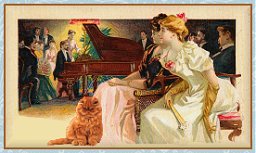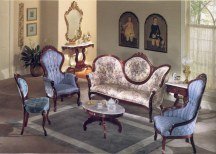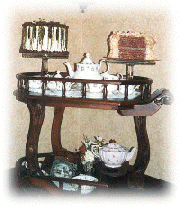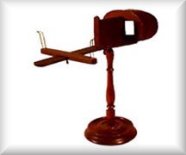The best room in the house in Victorian times was the parlor!
There were fringed pillows, portraits in ornate frames, Oriental
rugs and porcelain figurines...all things a cat could love!
The parlor was the social area...reserved for company and
special events. Before homes had telephones, paying calls was
the polite form of communication. Someone arriving would be
shown into the parlor, under the watchful scutiny of the cat,
while they waited for the mistress of the house to appear.

Dinner guests always gathered in the parlor before they were
led to the dining room. After dinner, the men retired to the
library to enjoy a cigar or sip brandy while the women went into
the parlor to chat or play the piano. Both sexes enjoyed the
parlor games that become popular in the late 19th century.
Weddings, funerals, special parties and receptions also took
place in the parlor.
Victorian memfurs are invited to continue our discussion on
the parlor in this fascinating era.
Victorian families were among the first ever to be blessed with abundant free
time, and among the last to pass that time without television. They enjoyed
numerous interactive parlor activities, ranging from cards (euchre, bridge,
seven-up) and board games (dominoes, checkers, chess) to 20 Questions and
charades. Young ladies and their mothers spent their leisure time learning
needlecrafts, creating ornaments, and reading novels. Popular titles of the
age include Sir Arthur Conan Doyle's ADVENTURES OF SHERLOCK HOLMES and L.
Frank Baum's THE WIZARD OF OZ. Male and female family members alike
frequently gathered around a parlor organ, a piano, or a player piano to have
"a sing." New entertainment technologies of the year included the phonograph,
a stand-alone console for playing back recorded audio programs, and the
stereograph, a handheld device for viewing 3-D-like images.
Article Courtesy of
Parlor Games
Purrs,
Bastet
 |
Here is a beautiful set of furniture to grace a Victorian parlor. Personally
this furniture does not look that comfortable to me to take my naps on. I
prefer my own livingroom set as it's cushions are softer. Also I would like
my Meowmie to serve me a spot of catnip tea. She can wheel the tea wagon
into my parlor for me. |
|
Victorian families were the first to be blessed with free time. They were
among the last generation to pass that free time before the advent of
television. They enjoyed numerous interactive parlor activities circa 1900.
These activities ranged from cards, (euchore, bridge, seven-up) and board
games (dominoes, checkers and chess). They also played 20 Questions and
charades.
Young ladies and their mothers spent their leisure time learning
needlecrafts, creating ornaments, and reading novels. Popular novels at that
time included Sir Arthur Conan Doyle's Adventures of Sherlock Holmes and L.
Frank Baum's The Wizard of Oz.
Male and female families gathered around a parlor organ, or a player piano to
have a "sing." |
|
New entertainment technology of circa 1900 included the phonograph, a stand
alone console for playing back recorded audio programs, and the stereoscope,
a handheld device for viewing 3-D-images.
At one time the stereoscope and view cards were found in every American home
from the 1850s to the beginning of W.W.I. The stereoscope allowed our
ancestors to view every corner of America and the rest of the world. It
provided a three dimensional history of those years. |
|
The first stereoscope was created by British inventor Sir Charles Wheatstone
in 1833. Photography was unknown at that time, so drawings were used. By
1850, crude stereoscopes and glass views were available. Tintypes, Albumen,
Daguerreotypes, and flat mount paper Stereographs followed. Sir David
Brewster invented a box shaped viewer that was popular then.
In 1859, Oliver Wendell Holmes developed a handheld viewer and David Bates of
Boston made improvements on it and manufactured them. With advancement in
photography at that time a new industry and form of entertainment was
created.
Stereo pictures are taken by a means of a camera with two lenses. The result
of this was two separate pictures 2.5 inches apart. Although the pictures
appear identical, they are not. When looked at in a viewer which has
prismatic lenses, your eyes will blend the two views into one and the brain
perceives it as three dimensions, the same as normal vision.
Rapid transportation, radio, movies and other forms of entertainment created
the demise of stereoscope and by 1920, only one company survived.
My Meowmie's Grandmeowmie Edith Gray of Roxbury, Massachusetts had one of
these in her family parlor. My Meowmie remembers using them at her town
library when she was a furry young girl. She also used a stereoscope at her
Grandmeowmie's friend's home when she visited there. Now these old
stereoscopes are collector's items.
Click here: Library
Images
Purrs, Lloyd |
Click here: Antique Treasures
|
Sir Wally,
This site is dedicated to a sewing Museum where sewing collections are on
display. There are many beautiful antique thimbles shown that were made by
several different companies. Make sure that you see all of these beautiful
antique thimbles.
Purrs, Lloyd
Hello
I have found a wonderful online store from the UK
where you can buy beautiful victorian things (there`s
even a victorian kitty collection)! You can find this
great page HERE
It is called PAST TIMES ONLINE.
Purrs, Cleo |
EMAIL
HOME
Some Graphics By
CATSTUFF
Sir Wally's Plaque By
Meow City
Some text from: Parlor Cats by Cynthia Hart, John Grossman
and Josephine Banks! Workman Publishing Co.
|



